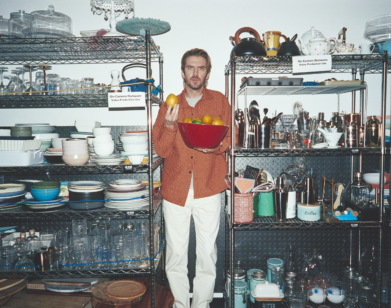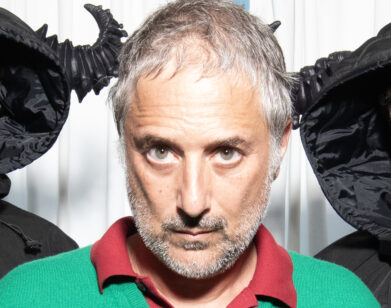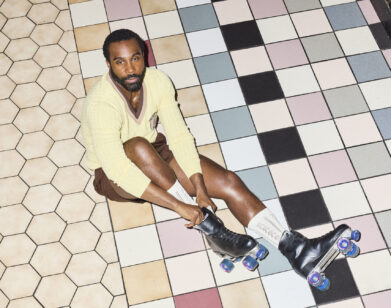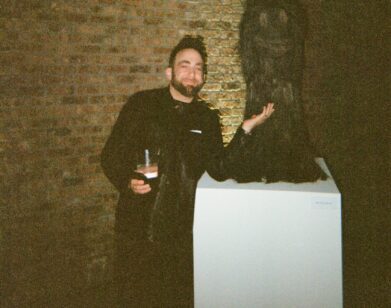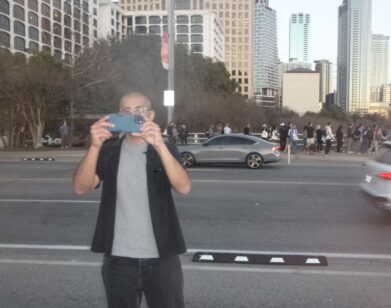What it Feels Like for a Girl
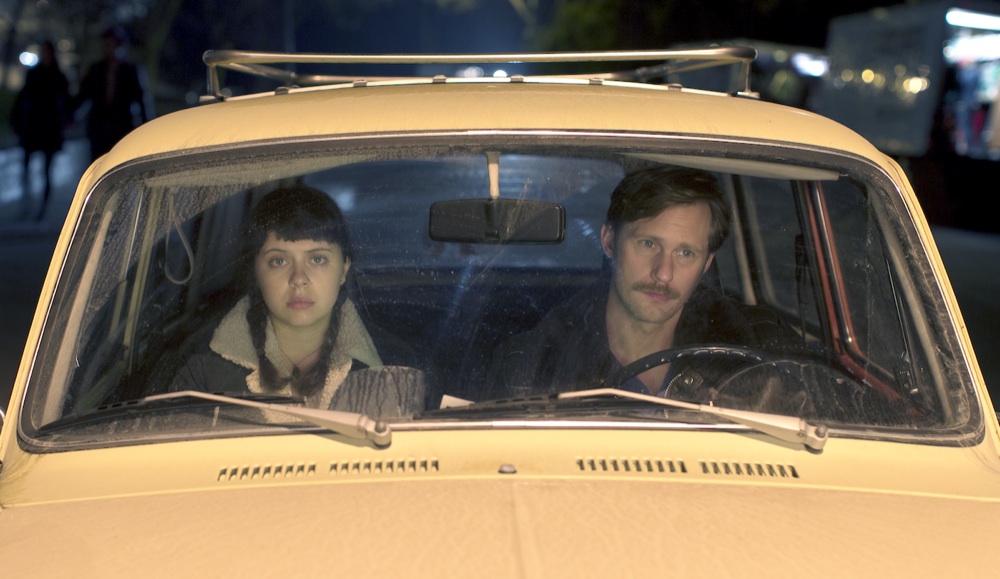
BEL POWLEY AND ALEXANDER SKARSGARD IN THE DIARY OF A TEENAGE GIRL
2015 may be far from over, but Lena Dunham has boldly banged the gavel on her favorite film of the year. “Run don’t walk!” she tweeted to her 2.4 million followers, urging them to go see Marielle Heller‘s “beautiful, important funny movie” The Diary of a Teenage Girl. That Dunham is championing the film should come as no surprise; the storyline could have been plucked from a lost episode of Girls.
Minnie (Bel Powley), a 15-year-old budding artist in ’70s San Francisco has got a throbbing, irrepressible crush on her mom’s boyfriend Monroe (played by perennial hunk Alexander Skarsgård). She ends up losing her virginity to him and spills all the juicy details the next day to her trusted tape recorder. Minnie grows rather fond of her hump-n-dump sessions with Monroe and corners him at every opportunity to continue their clandestine relationship, right under the nose of her alcoholic mother (Kristen Wiig).
Adapted from a graphic novel by Phoebe Gloeckner, The Diary of a Teenage Girl landed in first-time director Heller’s lap by way of a Christmas gift from her sister. She read it, loved it, and became all consumed by it, eventually “stalking Phoebe [Gloeckner] and her agent until I got the rights to adapt it.” The result was a successful theatrical play with Heller in the lead. Even after the last curtain call, however, Heller wasn’t able to shake the story’s clinging hold on her. She needed to see it on the big screen.
That eight-year labor of love has ushered in a new kind of sexually confrontational film, one that makes no apologies for discomfiting its audience. It holds up one particular finger to the hackneyed notion that young girls should stifle any instance of a dirty thought. The amount of nudity alone puts the entire Girls box set to shame. Just don’t go comparing it to Lolita…
TREY TAYLOR: How did you first react when you found out the film received an R rating and an 18 rating in the UK?
MARIELLE HELLER: I was happy for an R rating here. I never expected it to be anything softer than an R rating. I was just happy that we didn’t get an NC-17 rating and I was totally shocked that we got an 18 in the UK. I assumed we were the most prudish of all the countries and that they were going to be much more accepting of a story about sexuality. I never even thought there was a chance that we were going to get such a strict rating there. I was just shocked.
TAYLOR: When you were first holding auditions for the role of Minnie, did you have to warn everyone who auditioned that there would be a lot of nudity?
HELLER: Yeah, definitely, but I think anyone who read the script basically could tell that this was a movie about coming-of-age and sexuality and if they wanted to audition they should know that. So I am sure there are people who didn’t audition because of that, but all of the young women coming in to audition knew what they were getting into.
TAYLOR: There is a huge underlying message of body positivity in the film. Was that intentional?
HELLER: I think showing a real human body and a woman who is looking at her body without shame—that alone is a radical notion. Showing a young woman who is honest about what she is experiencing and letting us into her most intimate, darkest thoughts, all of that is just promoting something that we don’t get to see about young women. I’m a feminist and wanted to tell a story about a young woman whom I found to be a hero. This [is the] heroine I had been looking for my whole life.
TAYLOR: I feel like there have been similar stories told before but it seems more pressing now that everyone is scrolling through social media, thirsty for likes on their selfie.
HELLER: It’s a tough time to be a teenager and in the movie, Minnie is recording her diary on a cassette tape that she hopes no one will ever listen to. Today I think she would be doing a video blog or something that everyone would be watching and giving her feedback on. She wouldn’t be able to explore herself in such a personal way. There is this feeling that someone is always watching the things you do now, which I think is hard.
TAYLOR: So do you think the story could happen in 2015?
HELLER: Oh, totally. Things like this happen all the time. I think there is something different about it happening in the ’70s. That was a very specific cultural time and place. San Francisco in the ’70s, the cultural norms were very different to how they are now. There was this feeling of like, explore!
TAYLOR: Minnie’s friend Kimmie seems to be so sexually open and wears more provocative clothing, was that to show how Minnie is a bit afraid to come out of her shell?
HELLER: I think that’s just to show the truth of what it’s like to be a girl. A lot of girls are exploring their bodies and their sexuality as they become teenagers. We suddenly have this kind of power and we start to figure out how to yield it. I know I dressed way too provocatively when I look back. I was in that weird phase of feeling suddenly like my body was a woman’s body and not a kid’s body.
TAYLOR: Were you worried that the film might be too sexually provocative?
HELLER: No, I wasn’t. It had to be truthful and it’s all from a female perspective. The majority of the nudity is actually in scenes that are not sexual, scenes where [Minnie] is looking at her body in the mirror. Because I am a female filmmaker and I was telling the story from Minnie’s perspective, I tried to be really conscientious—I wasn’t trying to make a titillating sex story about a teenage girl where you feel like this young actress has been exploited and made to do all these horrible things. We were just telling the story about coming-of-age and you can’t really do that without showing some nudity and sex.
TAYLOR: Other films that have this coming-of-age arc don’t really have any of that. Nudity is so taboo; it’s so weird.
HELLER: It is so taboo! In some ways the nudity in this really makes people feel more uncomfortable because it’s not nudity that is just making bodies look like sexy little pieces of body parts stuck together. It’s much more blunt and real and there is not a sexy soundtrack behind it all.
TAYLOR: Bel Powley is great in the role of Minnie. How important was it to find someone who was super comfortable in their own skin?
HELLER: It was crucial. It was really important to find this super complex actress to play this young woman who embodies all of the different elements that make up Minnie. I think teenage girls are often portrayed as really two-dimensional and this was a very complete human character, very flawed. She always felt that the nudity was inherent to the story and made a lot of sense. Anything that didn’t make sense we were able to talk through. She never questioned it. We talked a lot about the scene where she is standing in the mirror. She understood it right away and how important it is, but we talked a lot about what we are going to see and why and set up really clear parameters so when we got to the filming of it she could just get lost in it.
TAYLOR: What’s the most offensive question you’ve had to deal with around the film?
HELLER: Someone at a screening in Utah tried to ask me if I was trying to glorify or condemn pedophilia.
TAYLOR: What did you say?
HELLER: I said neither. I’m just trying to tell an honest story about what it feels like to be a teenage girl.
TAYLOR: What do you make of the Lolita comparisons?
HELLER: Lolita is a fantastic movie but I don’t think this is Lolita at all. It’s a movie from the female perspective and it’s really not suppose to be something that makes you more afraid of female sexuality but hopefully makes you less afraid of it.
TAYLOR: Do you think your film will give frigid teens a sort of sexual boost?
HELLER: I don’t think any movie is going to make some kid run out and have sex. I think the truth of the matter is most teenage girls and boys are having sex or at least thinking about it. We just try to ignore that as a society and ignoring that is not making it any less true. This movie is just going to reflect the truth. I was a pretty horny teenage girl. I was thinking about sex all the time and I never saw any representation of that, so I felt something was really wrong with me! I hope if anything this should make some teenage girls think, “I’m not a freak because I think about all this stuff.”
TAYLOR: A lot of people are saying they wish they had a film like this when they were young. Why do you think they are saying that?
HELLER: I wish I did. Boys have stories about them that feel so representative of them and their experiences. Seeing yourself reflected on screen is a very important part of being human. It makes us feel less alone, it make us feel more connected to humanity. Women, gay men, and trans people for a long time have not seen themselves represented, so being able to show the complexities that we all have—just as complex stories as a heterosexual white male—is crucial for us to feel more human and have other people see us as human beings. I think things like pornography perpetuates this idea that women are just there as objects of male desire and are not complex people with their own sexuality and humanity.
TAYLOR: People are also saying, “We’ve seen this before!” It’s like they’re saying there isn’t room for this film, yet nobody complains about the fact that there is a comic book movie every year…
HELLER: It makes people uncomfortable! It makes white men uncomfortable that there aren’t more stories about them because it somehow is perpetuating the idea that they aren’t the center of the universe—and they wouldn’t give up that position lightly.
THE DIARY OF A TEENAGE GIRL COMES OUT TODAY, AUGUST 7, IN SELECT THEATERS.

